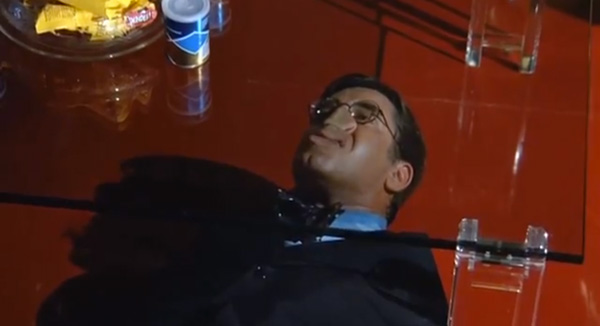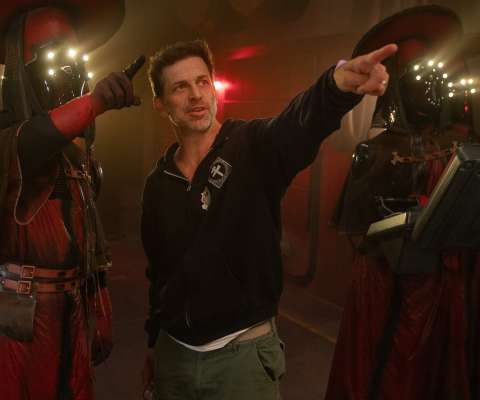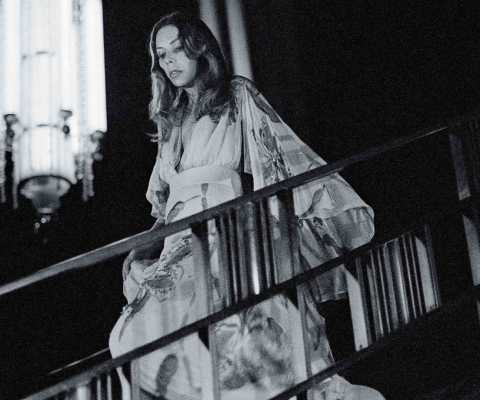Appearing on The Dick Cavett Show in 1980, Jean-Luc Godard was asked if he found Jerry Lewis funny. “I think he’s very funny,” replied Godard. “Even when he’s not funny, he’s more funny.” The French critics have given us plenty of cogent analysis of the art of Monsieur Lewis, but this simple statement may be the most perfect appraisal of all. It’s easy to complain that Lewis is imperfect – that his comedies are sloppy and undisciplined, that his on-screen wackiness goes too far, that his off-screen demeanor is abrasive and egotistical, and that all three have a tendency towards the bathetic. But to my eyes, such complaints miss the point, as if Lewis’ particular brand of manic, id-driven comedy would be better if he was less like Jerry Lewis and more like Charlie Chaplin.
I believe Lewis is valuable precisely because he’s completely unstable. We can easily separate Chaplin’s unsavory private life from the greatness of his art, but when Buddy Love shows up with the Brycleem in his hair and the wedding band on his finger, we know he’s the same man we’ve seen berating stagehands on the Labor Day Telethon. Well, if Chaplin the director was ever bit as precise and elegant as his on-screen Little Tramp, then Jerry the director is every bit as wild, ghastly, uncomfortable, innovative, self-indulgent, and occasionally brilliant as Jerry the actor. Nowhere is this more apparent than in his little-loved Cracking Up (1983), a late-period oddity that perfectly encapsulates everything wonderful, horrible, and wonderfully horrible about Jerry Lewis.
From 1949 to 1970, Lewis starred in 39 comedies, nine of which he also wrote and directed, becoming not simply a comedian but also (in his words) a “total filmmaker” in the tradition of Chaplin and Keaton. Following the indifferently received Which Way to the Front? (1970) and the never-released The Day the Clown Cried (shot in 1972), there would be no Jerry Lewis films until Hardly Working (1980), a truly dire low-budget exercise in which the now-fiftysomething comedian huffed and puffed his way through a series of creaky routines. Despite that film’s surprise box office success, Warner Bros. dumped Lewis’ superior Cracking Up straight to cable, and the film has gone largely unseen except by the most devoted Lewis apologists. It’s not hard to see why Warner got cold feet: 23 years after The Bellboy, and the same year that the top-grossing comedies included Trading Places and Porky’s II, 57-year-old Jerry Lewis was still stubbornly making Jerry Lewis movies.
Cracking Up has all the signifiers of a Lewis-directed film. Like most of his work, and especially The Bellboy, its narrative is a procession of barely-related vignettes, sight gags, and blackout sketches, tangentially held together by a misfit protagonist. It has a soundtrack full of big-band swing, sets full of modernist furniture, and production design emphasizing eye-popping primary colours. Once again, the film is proudly artificial, calling attention to its own movieness nonstop – usually in the form of Lewis’ pained reaction shots to the camera, but also in the final scene, when he goes to a cinema to see the very film we’ve been watching.
As usual, the free-form chaos is just barely held together by Lewis the actor, once again playing a born loser, a failure at everything he does, a walking disaster (or so we’re repeatedly told). Earlier Lewisian protagonists were generally defined by their jobs – a bellboy, an errand boy, a nutty professor, etc. This character gets only a name (“Warren Nefron”) and a state of mind (suicidal). After several botched suicide attempts, Warren goes to work out his problems with a psychiatrist (Herb Edelman). Their conversations become a clothesline for the gags, but Lewis is so obviously uninterested in a coherent narrative that the sheer thinness of this framing device seems part of the joke (Warren says he had French ancestors, so all of a sudden we’re in 17th century France…). In 1960, Lewis felt the need to begin The Bellboy with an introduction explaining that the film would be “a film based on fun… there is no story, no plot, it is a series of silly sequences.” Here, Lewis takes his stream-of-consciousness aesthetic much further by abandoning the narrative almost completely.
As usual, some of the gags are dismal (a scene in which the psychiatrist is pulled off a balcony by King Kong is foiled by crummy special effects), some are affably hoary (a sultry-voiced lady is actually Milton Berle in drag), some are pretty funny (an extended set-piece in which Jerry finds himself on the world’s cheapest airline), and the majority exist somewhere outside conventional categorization. Like Jacques Tati and Buster Keaton, Lewis is often less interested provoking belly laughs than in calling attention to the physical beauty of a mathematically precise piece of physical comedy. Consider the famous typewriter routine from Who’s Minding the Store?, or the celebrated sequence from The Patsy in which he keeps catching vases just as they’re about to hit the floor – scenes that are like dance performances in the medium of comedy.
Deserving mention alongside those classic moments is Cracking Up’s opening credit sequence, in which Lewis orchestrates a pratfall onslaught through the psychiatrist’s squeaky-chic office. Lewis-the-actor’s impossible spryness is complemented by Lewis-the-director’s keen visual sense: the furniture and floors are every bit as bright and shiny as Jerry’s famous hair. It is a remarkable piece of performance art, and one admires how much mileage and momentum Lewis the director/performer can gain from such a slim conceit. However… is it “funny”? Somehow that word seems too constricting. Like the typewriter bit (and, indeed, like a lot of scenes in Cracking Up), the pratfall symphony doesn’t exactly make me laugh, but it is uncommonly beautiful.
But more than anything, we know that Cracking Up is a Jerry Lewis film from its deep strata of melancholy. The key obsession running through Lewis’ directorial work is his characters’ struggles to be loved by others while also loving themselves. Warren Nefron takes the Lewisian protagonists’ self-loathing to its logical conclusion: suicide. But hang on – why does this so-called “born loser” wear tailored suits and polished loafers? How does he afford that flashy jewelry? Why does he have so much goddamn goop in his hair? Well, because he’s not really “Warren Nefron” at all. Out of all the major screen comedians, Lewis’ films may be the most nakedly revealing, and not just intentionally. That Lewis can’t even allow himself to play a loser without looking spiffy is Cracking Up’s perfect irony.
Aside from a few TV episodes and a short contribution to a UNICEF omnibus film, Lewis has not directed a movie since, and it’s reasonable to assume that Cracking Up will become his swan song. That feels right. While Cracking Up is not really in the same class as The Nutty Professor, The Bellboy, The Ladies Man, or The Errand Boy, it does feel like a summation of his self-directed work – the final, ultimate Jerry Lewis movie. In fact, the only thing that seems missing is his weakness for Chaplinesque sentimentality. There are no gooey speeches about loving oneself, no WASPy ingénues to look on adoringly. For all its flaws, Cracking Up is the work of a distinctive, confident filmmaker – an artist free from convention and fashion. Jerry Lewis never became the second coming of Charlie Chaplin like he so obviously craved, but to his credit, he did become Jerry Lewis.









Comments